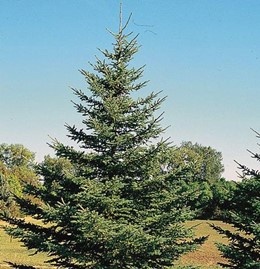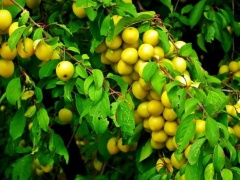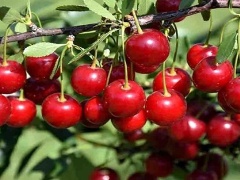
Our urban forest creates a lush green canopy for everyone to enjoy. From banding and pruning to watering and planting, learn how to maintain and take care of our trees.
How to Plant & Care for a TreeView some of the recommended tree species in Regina, and find information on how to best care for each tree.
View recommended tree species in Regina, and find information on how to best care for each species.

Height: 16 feet
Spread: 10 feet
This is a small deciduous edible fruit tree ready for picking in August. The fruit is golden/yellow coloured and very sweet eaten fresh. This fruit tree requires a pollinator to produce fruit. Requires full sun.

Height: 10 feet
Spread: 10 feet
This is a small deciduous edible fruit tree ready for picking in August. The fruit is orange/red coloured and sweet eaten fresh. This fruit tree is one the best pollinators for other plums. Requires full sun.

Height: 10 feet
Spread: 7 feet
This is a small deciduous edible fruit tree ready for picking in mid-summer. The fruit is sweeter and used for fresh eating, cooking and baking. This fruit tree is a self-pollinating variety. Requires full sun.

Height: 35 feet
Spread: 35 feet
This is a large deciduous tree with a round canopy. This tree has a unique fall colour resembling a pumpkin orange/red shade.
Amur Maple/Acer ginnalaHeight: 20 feet
Spread: 16 feet
Amur Maple is an incredibly colourful tree. As summer turns to fall, its bright green leaves turn fiery red. This tree is perfectly suited for urban environments. Its small size allows you to plant it in city yards and beneath power lines. Amur maple can also tolerate urban pollution, moist to dry conditions and is not affected by soil type or pH.

Height: 60 feet
Spread: 25 feet
This white spruce is a very large conifer with needle-like leaves and slender cones. Very hardy for the prairies.

Height: 10 feet
Spread: 6 feet
This small conifer is ideal for tight spaces or smaller yards. The dark green needles coupled with small brown cones make this a perfect accent tree. Requires full sun. Very hardy for the prairies.






To support our Urban Forest, The Forestry Bylaw was amended to allow residents to plant trees on City property. Please view the documents below to learn more about planting trees on City property.
Planting trees on City property is subject to the application process and by approval of the City. Please email a completed application to PRCSAdmin@regina.ca. The applicant will be contacted with the final decision on the request.
Tree banding keeps fall and spring cankerworms from laying their eggs in the crown of the tree. Band your elms, Manitoba maples and fruit trees each spring and fall to reduce the amount of cankerworms. To band your tree:
Trees, when mature, should have a strong straight trunk and a full crown with well-spaced branches. Pruning helps achieve this growth pattern.
Pruning depends on the age of your tree:
Special pruning considerations for certain tree species:
A tree’s root system extends out at least as far as the tree is tall. Most of the tree's feeder roots are in the top 15 cm of soil. Therefore you will likely water and fertilize over a large area of your yard to provide proper nutrients to your urban tree.
If you placed mulch in a large circle around your trees, you may only need to water if there’s a drought. However if you haven’t mulched, you will need to thoroughly water your tree two or three times a season (e.g. beginning of June, July and August).
Near the end of August, stop watering until the trees have dropped their leaves. This allows the trees to harden for winter. Once the tree’s leaves have fallen, give both trees and shrubs a good soak each week until the ground freezes. This practice helps plants withstand Regina’s dry winter conditions.
Follow the Forestry Bylaw to learn more about caring for a City-owned tree. The bylaw lists many things that you cannot do to a City-owned tree including:
Trees on City property are “living” assets owned and maintained as a legacy for residents by the City of Regina. The City aims to protect, preserve and perpetuate the health, beauty and safety of the urban forest for the enjoyment of its citizens, past, present and future.
In an effort to ensure that all trees on City property are adequately protected from unnecessary destruction, loss and damage, a policy has been established that outlines the standards and requirements. Please review the policy for eligibility before applying for tree removal services.
Note: All other tree related requests (i.e. pruning, change in tree species) require a Service Request.
The applicant will be contacted with the final decision of the request. Tree removals can only be performed by City staff or City designate.
Root ProblemsSometimes tree roots from City-owned trees will invade your drainage or sewer pipes, appear on your lawn, or lift your driveway or sidewalk.
Are you doing some improvements to your house or yard this year near City-owned trees? If so, you are required to protect them from any construction, demolition or landscaping work you may do.
Submit a tree preservation plan for the site to the City of Regina prior to the start of construction. The Tree Preservation Plan should include the following items:
The City of Regina’s Tree Replacement Program extends the life of our urban forest by replacing dead, diseased or damaged City-owned trees on municipal property in parks, residential and arterial streets and boulevards.
A limited number of trees are available for this program each year. Requests will be granted on a first-come, first-served basis. Upon receiving your request, City staff will inspect your yard to assess whether a new City-owned tree can be accommodated, where the tree can be planted, and which species is suitable based on: